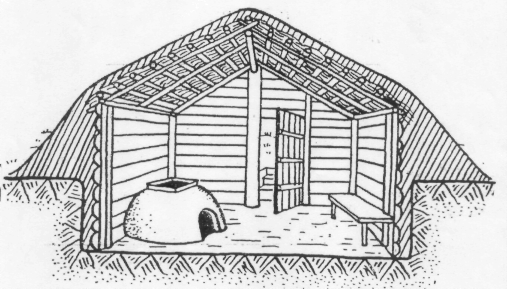
Unit II from the history of building in slavic countries and great britain
I. Pre-reading task
What ancient building materials do you know?
What were the first dwellings?
Why do you think it is important to know the history of building and construction?
Vocabulary
|
Ancestor |
Предок |
|
Adjusment |
Установка, сборка |
|
Affluence |
Обилие, богатство |
|
Chimney stack |
Дымоход |
|
Cob |
Глина |
|
Craft |
Ремесло |
|
Distortion |
Деформация |
|
Face |
Облицовывать, покрывать |
|
Frame |
Каркас |
|
Frontage |
Фасад |
|
Grid |
Решетка, сетка, решетчатая конструкция |
|
Impose |
Навязывать |
|
Improvement |
Реконструкция |
|
Jerry-builder
Bodge (bodgery) |
Подрядчик, возводящий непрочные строения Плохая работа |
|
Jetty |
Выступ, эркер |
|
Kiln |
Печь |
|
Lath |
Дранка, решетка, рейка |
|
Lease
To take out a lease Tenant |
Аренда, договор об аренде, срок аренды Подписать договор аренды Владелец, арендатор, житель |
|
limewash |
Известковая побелка |
|
Main(s) Mains drainage |
Магистраль, трубопровод Магистральный осушительный канал |
|
Mortar |
Строительный раствор |
|
Mud hut |
Землянка |
|
Opt for |
Выбирать |
|
Overindulge |
Злоупотреблять |
|
Peg |
Соединять кольями, дер. дюбелем |
|
Plank |
Толстая доска |
|
Plaster |
Штукатурка |
|
Prefabrication |
Сборная конструкция заводского изготовления |
|
Pull down |
Сносить |
|
Quoin |
Угловой камень кладки |
|
Regulation |
Устав, норматив |
|
Rendering |
Обрызг, первый слой штукатурки, обмазка |
|
Salmon |
Оранжево-розовый (сомон) |
|
Semi |
Дом, примыкающий к другому |
|
Settlement |
Поселение |
|
Sewage |
Нечистоты |
|
Shaft |
Столб |
|
Shell |
Каркас, остов |
|
Shoddy |
Низкопробный |
|
Shutter, shuttering |
Опалубка |
|
Site |
Строительная площадка |
|
Slab |
Плита, кусок |
|
Slum |
Трущоба |
|
Waterproof |
Водонепроницаемый |
|
Wattle and daub |
Мазанка |
|
Сrack |
Трескаться |
Text I slavic houses

Construction of a house that has now been transformed just into the technical act was filled with a profound religious sense for our ancestors. At that times one built his dwelling for his family mostly himself - and if needed with help of relatives, neighbors and friends. So called 'other hands' (professional builders associations) has emerged not long ago: they have been freely engaged only since the beginning of the XXth century. Formerly, people took them not only for experts. Even in the end of the IXth century they were considered to be powerful sorcerers holding lives and deaths of people living in houses built up by them.
Building process itself was a solemn action compared to creation of the world. Certainly it supposed not only specific attitude to this process but a great number of magic operations containing choosing optimum materials for the house, place for future "domestic Universe", time for starting building and etc.
It is known that timber was the main building material for the Slavs. Legends say that first people were made of timber - it means that trees are older and wiser than people. To cut down a tree - it's the same as to kill a man! But people needed home. What's to be done? Not every tree could be cut down. Holy trees were never cut down. By the way, at that time people believed that human soul could live in a tree and the indication of it was a creak emitted by tree: souls of tortured people were crying in that trees according to beliefs. One who deprives them of shelter will be surely punished: loose his health or even life. Trees with anomalies (big hollow, ingrown stone or other things unusual form of trunk etc) were not used. There were bans on cutting down some breeds, so called "accursed" trees: asp and fir. Dead and faded trees were not used too. Such trees didn't have vital energies and have a sigh of death - they could bring it into the house. If a tree fell and its top was turned to the North it was not used too. If such tree had been fitted in shell people wouldn't have lived long in that house. This part of the world (North) our ancestors associated with eternal gloom, winter, lifeless cold - the other world. Special and very dangerous tree variety was "violent" trees. Such trees were often standing on the abandoned roads and especially on their crossroads.
Ancient Slavs were absolutely aware of the fact that while a tree was being cut down itwas suffering from strong pain and crying. That's why they believed that one should take its hat off, kneel down and tell about your need that forced you to finish its life. Then some kind of treating (pieces of bread with butter) should be put down near the tree so that timber soul could go out and didn't suffer too much.
In VI-VII centuries Slavic dwellings were called half-mud-huts. Dimensions of such houses were 3x4 meters and the roof was often rested right on the ground. There were 2 ways of wall erecting. Sometimes timber shell was made in the pit. Sometimes walls were made of poles and blocks. Such walls could be easily destructed without extra support and couldn't carry the roof. That's why thick and strong shafts were fixed in each corner and in the middle of each wall.
The entrance of this dwelling was, as a rule, in the South. The main aim of the ancestors in severe climate was to keep warmth inside the house. That's why space around the walls and the roof were filled up with ground and there weren’t any windows in the thick timber-ground walls. But door opened to the South (to the sun) was an additional source of heat and light in summer.
